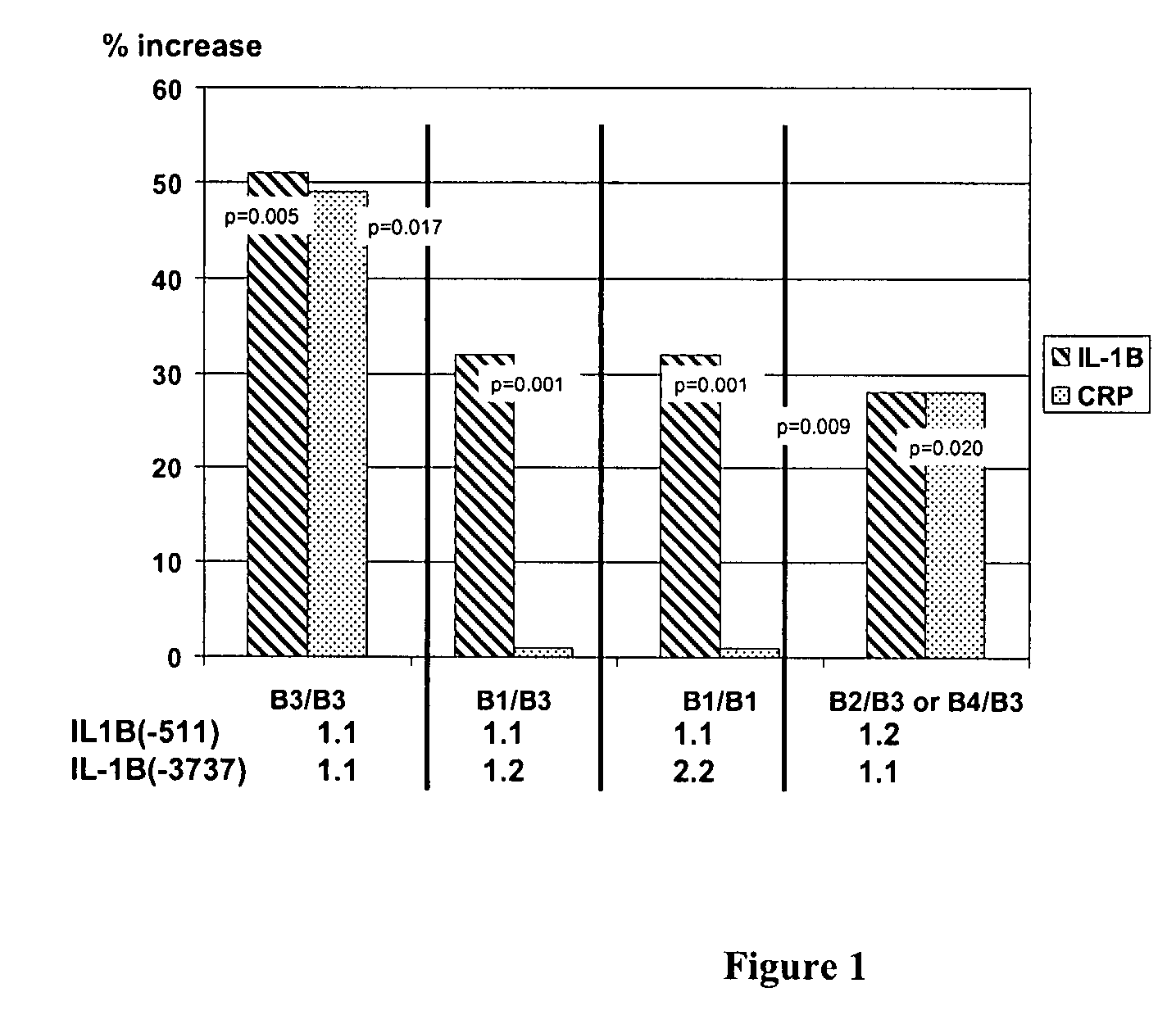IL-1 gene cluster, insulin resistance and coronary artery disease associated polymorphisms and haplotypes and methods of using same
a technology of which is applied in the field of il1 gene cluster, insulin resistance and coronary artery disease associated polymorphisms and haplotypes and methods of using same, can solve the problems of increased blood glucose levels after meals that do not properly stimulate insulin production by the pancreas, extensive tissue damage, and impaired insulin secretion, so as to increase the expression level of c-reactive protein
- Summary
- Abstract
- Description
- Claims
- Application Information
AI Technical Summary
Benefits of technology
Problems solved by technology
Method used
Image
Examples
example 1
Genotyping Methods
[0169]Preparation of DNA
[0170]Blood is taken by venipuncture and stored uncoagulated at −20° C. prior to DNA extraction. Ten milliliters of blood are added to 40 ml of hypotonic red blood cell (RBC) lysis solution (10 mM Tris, 0.32 Sucrose, 4 mM MgCl2, 1% Triton X-100) and mixed by inversion for 4 minutes at room temperature (RT). Samples are then centrifuged at 1300 g for 15 minutes, the supernatant aspirated and discarded, and another 30 ml of RBC lysis solution added to the cell pellet. Following centrifugation, the pellet is resuspended in 2 ml white blood cell (WBC) lysis solution (0.4 M Tris, 60 mM EDTA, 0.15 M NaCl, 10% SDS) and transferred into a fresh 15 ml polypropylene tube. Sodium perchlorate is added at a final concentration of 1 M and the tubes are first inverted on a rotary mixer for 15 minutes at RT, then incubated at 65° C. for 25 minutes, being inverted periodically. After addition of 2 ml of chloroform (stored at −20° C.), samples are mixed for 1...
example 2
Subjects with High Inflammation Genotypes and Higher Levels of C-Reactive Protein (CRP), IL-6 and IL-1ra Had Higher Baseline Insulin Levels and Higher Insulin Resistance than Subjects with Low Inflammation Genotypes
[0201]As shown previously (U.S. Ser. No. 11 / 586,995, filed Oct. 25, 2006) alleles IL-1A (+4845) 1.2 or 2.2; IL-1B (+3954) 1.2 or 2.2; and IL-1B (−511) 1.1 are associated with higher levels of inflammation, as opposed to alleles IL-1A (+4845) 1.1; IL-1B (+3954) 1.1; IL-1B (−511) 1.2 or 2.2; and IL-1RN (+2018) 1.2 or 2.2. Female subjects who were overweight or mildly obese but otherwise in good health were selected for this study. All of the subjects were premenopausal, age 20-49 years, and the group of subjects had a mean BMI of 29. The subjects were genotyped to see if they fit into either of the higher or lower inflammation genotypes described above. The group genetically predisposed to higher levels of inflammation is referred to herein as the H group and the group gene...
example 3
The Use of IL-1B Genotypes to Predict IL-1β and C-Reactive Protein Levels
[0204]Inflammation appears to be a central mechanism in the initiation and progression of multiple chronic diseases of aging. Among overtly healthy persons, some individuals are consistently in the upper range for certain inflammatory mediators, such as IL-1β and C-reactive protein (CRP). Moreover, compared to those in the lower end of the spectrum, these individuals are at increased risk for many diseases. Factors such as smoking, body mass index, and hormone replacement therapy explain a portion of the variance of inflammatory mediators in overtly healthy individuals, but genetic differences also appear to be an important determinant of inter-individual variance in inflammatory mediator levels. Here we show haplotypes that are correlated with increased IL-1β expression and increased CRP expression, leading to the correlation of these haplotypes, and the alleles contained within these haplotypes with inflammat...
PUM
| Property | Measurement | Unit |
|---|---|---|
| Fraction | aaaaa | aaaaa |
| Fraction | aaaaa | aaaaa |
| Fraction | aaaaa | aaaaa |
Abstract
Description
Claims
Application Information
 Login to View More
Login to View More - R&D Engineer
- R&D Manager
- IP Professional
- Industry Leading Data Capabilities
- Powerful AI technology
- Patent DNA Extraction
Browse by: Latest US Patents, China's latest patents, Technical Efficacy Thesaurus, Application Domain, Technology Topic, Popular Technical Reports.
© 2024 PatSnap. All rights reserved.Legal|Privacy policy|Modern Slavery Act Transparency Statement|Sitemap|About US| Contact US: help@patsnap.com









